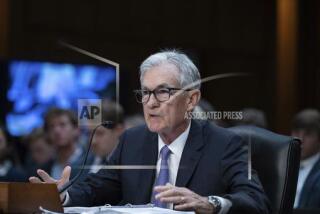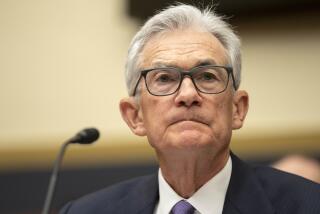Key Fed Panel Gets 4 New Faces for ’93
NEW YORK — The Federal Reserve may have to take up the prickly question of whether to raise interest rates next year, and its policy-making panel will have four new people to help decide the issue, economists say.
For the first time in two years, the 12-member Federal Open Market Committee for 1993 may have to tighten monetary policy, probably in the second half but possibly as early as the second quarter.
The economy at the moment is growing with low inflation--the best of both worlds, according to experts. The new FOMC’s job will be to keep the economy on track and stand ready to combat any sign of inflation accelerating.
Economists say the central bank is unlikely to tolerate any signs of rising inflation that could endanger the delicate recovery. That means the Fed could raise rates if inflationary signs crop up.
But the decision whether to raise interest rates is not likely to prove as jarring for the committee and its four new members as were the issues that faced policy-makers in 1992.
“I think their job is less nail-biting. The FOMC of 1992 had many sleepless nights wondering if we were having a recurrence of the 1930s,” said Ward McCarthy, a managing director at Stone & McCarthy Research Associates Inc.
The FOMC is made up of eight permanent members, including the seven Fed governors and the president of the New York Federal Reserve Bank. But each year, the four seats held among the 12 regional Federal Reserve bank presidents change.
Federal Reserve bank presidents who get voting rights next year are Edward Boehne of the Philadelphia region, Silas Keehn of Chicago, Robert McTeer of Dallas and Gary Stern of Minneapolis.
McTeer is least known by financial markets. He joined the Dallas Fed in February, 1991, and has no voting record on the FOMC. His background at the Richmond Fed, where he was senior vice president in charge of the Baltimore branch, may mean a fairly conservative hand on monetary policy.
“Everyone in Richmond wears a monetarist sports jacket,” McCarthy said.
Boehne is viewed as a moderate likely to go with the majority camp, and Keehn also is seen in that category.
“In Keehn’s last five FOMC terms he never dissented,” said Dana Sorrentino, economist at Citicorp Investment Bank.
Stern is also seen as unlikely to rock the consensus boat.
On the other hand, two outspoken inflation hawks are being rotated off the FOMC--Jerry Jordan of Cleveland and Thomas Melzer of St. Louis.
“We’ll see a more eclectic FOMC,” said Anthony Chan, senior economist at Barclays de Zoete Wedd Government Securities Inc. “People who are leaving are more obsessed with the money numbers.”
So at the margin, the new voting members may, as a group, have less of a fixation on money supply, economists said.
“They may be a little more pragmatic than the other crew, a little less of a monetarist bent,” said James Fralick, senior economist at Morgan Stanley & Co. Inc.
In a 12-member voting pool, however, the effect of their votes is limited, economists noted.
“The power of any one individual is limited, even that of (Fed Chairman Alan) Greenspan,” said Douglas Schindewolf, associate economist at Smith Barney, Harris Upham & Co. Inc.
More to Read
Inside the business of entertainment
The Wide Shot brings you news, analysis and insights on everything from streaming wars to production — and what it all means for the future.
You may occasionally receive promotional content from the Los Angeles Times.










